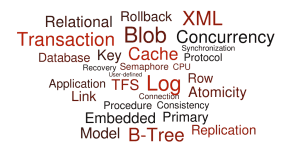The specialist vocabulary related to database systems can make the subject seem more difficult than it is. The following embedded database terminology list should help lift the veil.
Application Link – Direct link between application program and database functionality. Eliminates client/server overhead of Remote Procedure Calls (RPCs).
Atomicity – A characteristic of transactions where all updates are committed together, or none of them are.
Blob – Binary Large Object. Typically used for un-typed data such as graphics or PDFs.
B-Tree – A page-oriented indexing method that provides fast data access to disk-based contents.
Cache – Server memory containing most recently accessed data.
Concurrency – When multiple computing processes or threads are executed within the same time period.
Connection – The means of communication between a client and a server.
Consistency – Rules enforced by a DBMS to ensure data relationships and contents make sense.
Context – Data associated with a class of operations which allow greater concurrency.
Cost-based Optimization – An optimizing algorithm using database statistics to estimate the best access paths necessary to satisfy a query.
DBMS –Database Management System.
DDL – Database Definition Language.
Distributed Database – Database spread over several computers which have simultaneous access capabilities.
DLL – Dynamic Link Library.
DML – Database Manipulation Language.
Durability – Transactions that will survive system failures.
GUI – Graphical User Interface.
Hash – Indexing method that provides fast data retrieval. Hashing is specifically optimized for keys that have no collating sequence.
Hot Spot – An often-used part of a database that creates a performance bottleneck .
Implicit Locking – Automatic locks that ensure safe operation in a multiuser SQL.
Isolation – In multi-user DBMS usage, the prevention of one user’s uncommitted changes effecting another user.
JDBC – Java Database Connectivity.
Key – A column or combination of columns identified in DDL as identification for rows contained in a table.
Locking – A method for protecting data from being viewed while it may be changed by another user, or from being changed by more than one user at once.
Mirroring – The maintenance of one or more identical copies of an original database.
Multi-platform – Software able to run on many different computers and Operating Systems.
Optimizer – A component of the SQL system that estimates the fastest method to access data.
Primary Key – A Key which provides unique identification of a table row.
Protocol – A specific method in which messages are formulated, formatted, and communicated.
Read-only Transaction – A multi-version concurrency control feature that creates a virtual “snapshot” of a database, viewed by one process without locking and without seeing another’s modification of that same data.
Record Type – A collection of closely related data fields—equivalent to an SQL table.
Recovery – A procedure following a software or hardware failure which examines a database and all artifacts in order to produce the most recent and reliable state of the data.
Relational Model – A popular database architecture defining tables as a set of rows consisting of sets of columns. The term relational refers to the ability to create relationships (equal, greater-than, …) between column values in different tables resulting in new tables.
Replication – copying data to another database.
Result Set – The complete set of data that is returned by a particular SQL SELECT statement.
Rollback – An operation that cancels changes made by all insert, update and delete statements of a transaction. A rollback may be partial (rolling back changed only to a certain mark in a transaction), or complete (normally called a transaction abort).
Row – One set of related values for all of the columns declared in a given table. Also known as a record occurrence.
Schema – A description of the structure of a database.
Semaphore – Variable used to synchronize shared access to data.
SQL Stored Procedure – A set of statements written in a procedural language containing SQL query and change commands together with variables and conditional control flow.
Synchronization – Multiple methods of preventing independent threads of execution from viewing or modifying common data in an unsafe way.
Table – A collection of closely related data identified as named and typed columns.
Thread – A single, sequential execution of a program segment. Threads can be executed concurrently.
Transaction Log – A record of database changes used to update related databases and facilitate recovery.
TFS – Transactional File Server.
User-defined Function – An application-specific SQL callable scalar or aggregate function written in C.
User-defined Procedure – An application-specific function written in C and invocable through use of the SQL call statement.
XML – Extensible Markup Language.
Find the full list of database terminology here




























